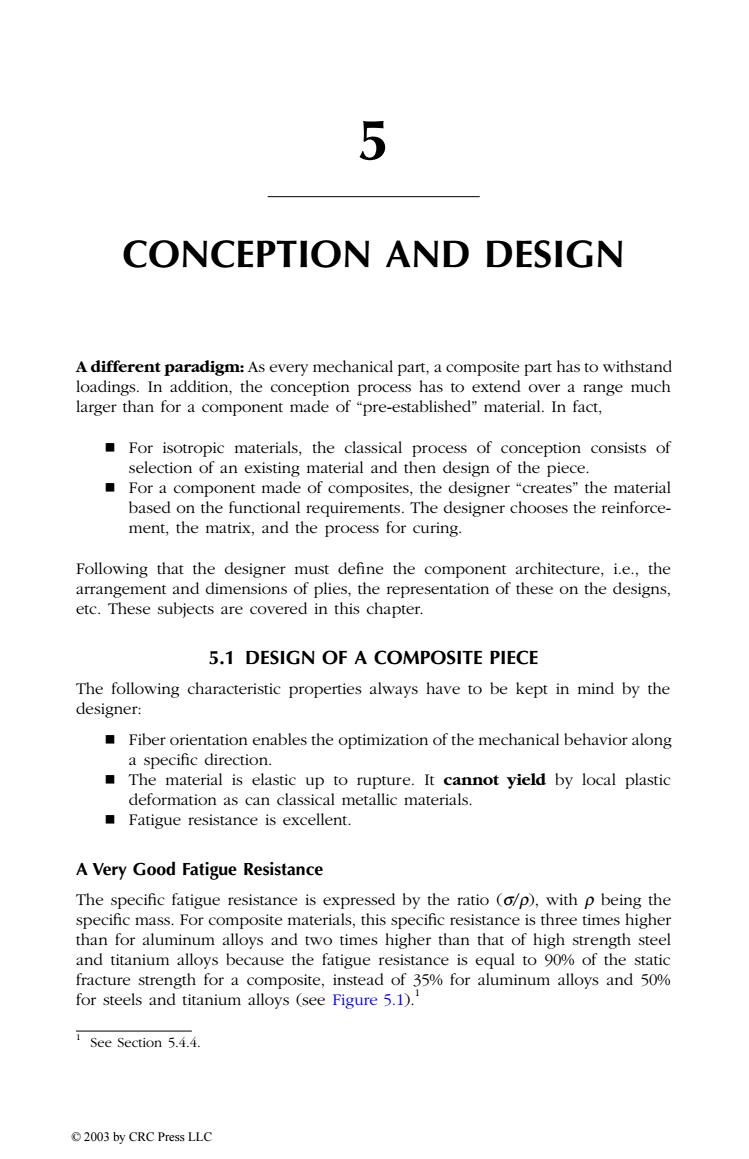正在加载图片...

5 CONCEPTION AND DESIGN A different paradigm:As every mechanical part,a composite part has to withstand loadings.In addition,the conception process has to extend over a range much larger than for a component made of "pre-established"material.In fact, For isotropic materials,the classical process of conception consists of selection of an existing material and then design of the piece. For a component made of composites,the designer "creates"the material based on the functional requirements.The designer chooses the reinforce- ment,the matrix,and the process for curing. Following that the designer must define the component architecture,i.e.,the arrangement and dimensions of plies,the representation of these on the designs, etc.These subjects are covered in this chapter. 5.1 DESIGN OF A COMPOSITE PIECE The following characteristic properties always have to be kept in mind by the designer: Fiber orientation enables the optimization of the mechanical behavior along a specific direction. The material is elastic up to rupture.It cannot yield by local plastic deformation as can classical metallic materials. Fatigue resistance is excellent. A Very Good Fatigue Resistance The specific fatigue resistance is expressed by the ratio (o/p),with p being the specific mass.For composite materials,this specific resistance is three times higher than for aluminum alloys and two times higher than that of high strength steel and titanium alloys because the fatigue resistance is equal to 90%of the static fracture strength for a composite,instead of 35%for aluminum alloys and 50% for steels and titanium alloys (see Figure 5.1).' TSee Section 5.4.4. 2003 by CRC Press LLC5 CONCEPTION AND DESIGN A different paradigm: As every mechanical part, a composite part has to withstand loadings. In addition, the conception process has to extend over a range much larger than for a component made of “pre-established” material. In fact, For isotropic materials, the classical process of conception consists of selection of an existing material and then design of the piece. For a component made of composites, the designer “creates” the material based on the functional requirements. The designer chooses the reinforcement, the matrix, and the process for curing. Following that the designer must define the component architecture, i.e., the arrangement and dimensions of plies, the representation of these on the designs, etc. These subjects are covered in this chapter. 5.1 DESIGN OF A COMPOSITE PIECE The following characteristic properties always have to be kept in mind by the designer: Fiber orientation enables the optimization of the mechanical behavior along a specific direction. The material is elastic up to rupture. It cannot yield by local plastic deformation as can classical metallic materials. Fatigue resistance is excellent. A Very Good Fatigue Resistance The specific fatigue resistance is expressed by the ratio (s/r), with r being the specific mass. For composite materials, this specific resistance is three times higher than for aluminum alloys and two times higher than that of high strength steel and titanium alloys because the fatigue resistance is equal to 90% of the static fracture strength for a composite, instead of 35% for aluminum alloys and 50% for steels and titanium alloys (see Figure 5.1).1 1 See Section 5.4.4. TX846_Frame_C05 Page 69 Monday, November 18, 2002 12:09 PM © 2003 by CRC Press LLC